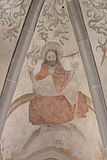St. Georg (Frauenberg)
The Catholic parish church of St. Georg in Frauenberg , a district of Euskirchen in the district of the same name in North Rhine-Westphalia , dates back to the 10th century. In the 15th century it was redesigned in the Gothic style. Late Gothic wall paintings have been preserved in the church. The most important piece of equipment is a triptych from around 1480.
history
The church of Frauenberg was initially a pilgrimage church consecrated to Mary , as the original name of the place Heilige Frau Maria auf dem Berche indicates. 1067 was provided by the Cologne Archbishop Anno II. The pen St. Georg passed and received its patronage .
The oldest parts of the church, the central nave and the four lower floors of the west tower, were built in the 10th century. The south aisle with a semicircular apse was added around 1100, and the north aisle was added around 1200. In the years 1220/30 the choir of the central nave with its ribbed vault was built and the tower was raised by a new bell storey. At the end of the 14th and in the course of the 15th century, the Romanesque north aisle was replaced by a wider and higher Gothic aisle and a choir with a three-eighth end. This is the main ship today.
The church suffered damage during World War II . A restoration took place from 1951 to 1955, during which the late Gothic wall and vault paintings were exposed.
architecture
The church is made of plastered quarry stone . The unusual, asymmetrical shape reflects the history of its creation. Of the three ships, the southern one is the smallest, the northern one the largest. The southern and central aisles open into a semicircular apse in the east . The north nave is a Gothic hall with a polygonal choir closure. A five-story tower adjoins the nave in the west .
Leaded glass window
The modern stained glass windows were made in 1965 in the Oidtmann stained glass factory in Linnich based on designs by Paul Weigmann (1924–2009).
Paintings
The decorative paintings on the vaults provide native plants and flowers. In the nave one of the radicals marshals God Four recognize that were especially revered in the Rhineland and also as Cologne marshals are referred to, a subject that also in the parish church Cross discovery in Elsig returns . In the north choir, a fresco depicting the Last Judgment has been preserved, as well as the painted coats of arms of the donors of the choir painting, the former owners of Bollheim Castle in Oberelvenich .
Winged altar
Behind the celebration altar is the painted winged altar by the master of the Ursuline legend of the late Cologne school of painting . It is dated to around 1480. The holy clan is depicted on the main panel, the Annunciation on the left and the Three Kings on the right . The founders of the triptych, Johann von Hompesch and his wife Katharina von Geisbusch, are represented with their family arms at the bottom of the picture.
organ
The organ comes from the workshop of Johann Heinrich Brinkmann , who installed it in the church in 1843. Early 20th century, especially after World War I , when the front pipes had to be delivered to military purposes, it was repeatedly rescheduled .
Further equipment
- The oldest piece of furniture is a Romanesque crucifix . It was created in Cologne around 1160 and is one of the rare wooden sculptures that has been preserved in its original color .
- The baptismal font dates from the 12th century and is made of Namur bluestone . It is designed with corner masks and relief depictions of monsters.
- The enthroned Madonna dates from the 14th century, the wooden sculpture of Bishop Anno from the 15th century.
Bells
A three-part bell hangs in the tower. The bells are tuned to the notes f '+7 g' + 4 b '+ 1.
literature
- The art monuments of the Rhine Province , Volume 4, Section 4: The art monuments of the Euskirchen district . L. Schwann, Düsseldorf 1900, pp. 55-60 (reprint: Schwann-Bagel, Düsseldorf 1983, ISBN 3-590-32119-9 ).
- Friends and sponsors of the Stadtmuseum e. V. (Ed.): The churches and chapels in Euskirchen. Euskirchen 2006, ISBN 3-00-019035-X , pp. 58-63.
- Walter Pippke, Ida Leinberger: The Eifel . Dumont, Cologne 2004, ISBN 3-7701-3926-7 , p. 129.
Web links
- Parish church of St. Georg in Frauenberg. City of Euskirchen, accessed on January 25, 2016 .
- F.-J. Vogt: History of the Brinkmann organ in the Church of St. Georg in Euskirchen-Frauenberg. Archived from the original on February 10, 2013 ; Retrieved January 25, 2016 .
Coordinates: 50 ° 41 ′ 3.4 ″ N , 6 ° 44 ′ 17.3 ″ E












